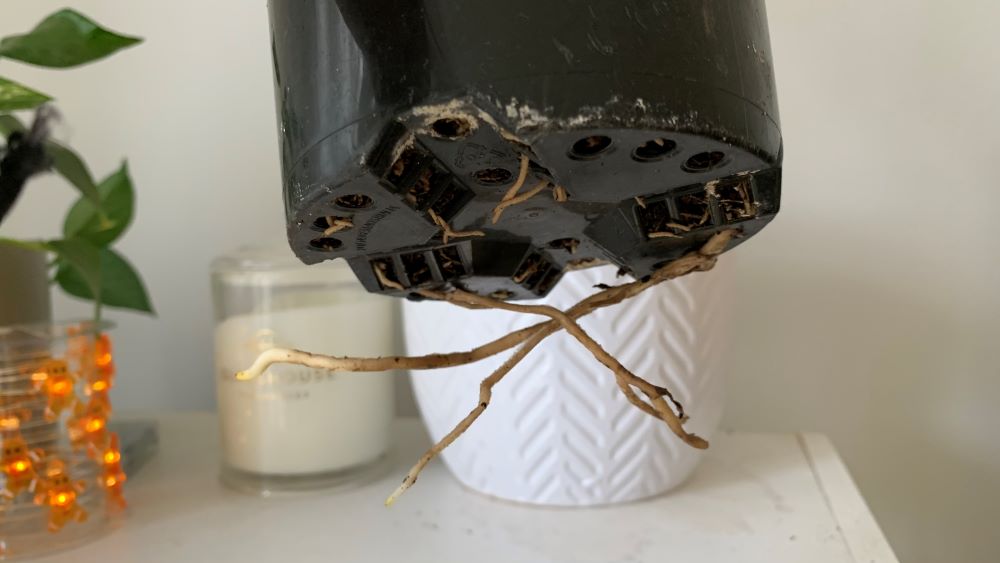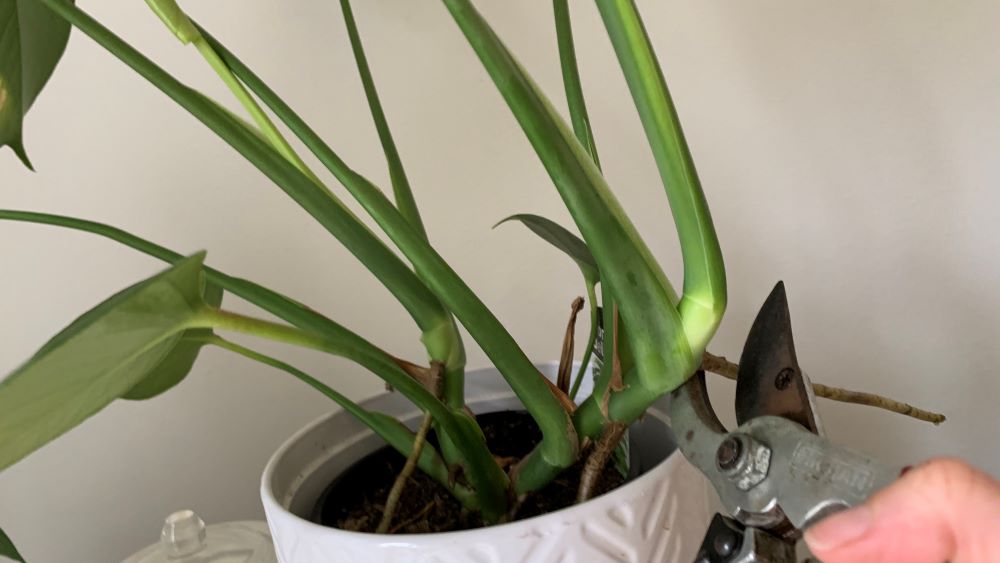Monstera deliciosa should be pruned to remove old, damaged leaves, balance the shape, remove old roots and clean up aerial roots. Make sure you wear gloves to keep the monstera sap off of your skin. Use sharp, clean secateurs to remove leaves near the base of the stem and to remove old roots.
This article will explore my top tips for pruning monstera deliciosa at home to grow large, beautiful plants with bright, green leaves.

Top tips for pruning monstera deliciosa
Here are my top 5 tips for pruning monstera deliciosa plants at home.
1. Protect yourself
The first step is to always protect your hands and arms when pruning monstera deliciosa plants. The sap that comes from monstera is an irritant and can cause irritation to your skin. Use gloves and wear long sleeves to keep the sap off your skin.
Wipe up the sap if it drips onto furniture or on the pot with a damp cloth. This will keep the area clean and avoid it getting on your skin.
2. Use sharp, clean cutting tools
Using sharp clean secateurs is the best way to trim off leaves or roots. I always like to use sharp, clean secateurs but you could use clean kitchen scissors or even a knife. Secateurs are a safe way to trim your monstera deliciosa and can cut through large stems up to 1 inch wide.

3. Prune before and after the growth period
The best time of year to prune monstera deliciosa is at the beginning of spring and then a second tidy up in fall. After the slower growth period of monstera in winter take the time to remove old leaves, damaged stems and long roots before it rapidly grows in spring.
Prune monstera again in fall before winter to shape the plant in the way that you want. You can remove excess stems that have grown off in the wrong direction, are leaning too far or putting the plant off balance.
4. Plan your cuttings
Before you prune your monstera deliciosa it is great to think about taking cuttings. Once your monstera has grown a long stem and a growth node, shown usually by an aerial root you can remove this and grow a whole new plant.
I like to look for a joint where the stem has started to bulge and an aerial root has started to appear. Cut below this section and place it in a jar of water. This piece will start to grow roots and can be ready to plant out into soil in as little as four weeks.

5. Clean up monstera deliciosa aerial and base roots
To keep monstera deliciosa looking tidy you can take some time to remove aerial roots that are growing too long or roots that are starting to grow out the bottom of the plant. If you want to keep your monstera in the same pot for the next year you can remove this excess root growth to keep it contained.
Aerial roots are growing out to search for more soil to dig into and absorb more nutrients. They can also help to grip onto a grow pole to hold onto the post and grow upwards. It is up to you as to whether or not you want to remove them but it does make the monstera look tidy.

How to prune monstera deliciosa roots
Monstera roots can be removed by using sharp secateurs. Clean the secateurs with some warm soapy water and wipe them dry. The roots will not release sap but it is still best to wear garden gloves when trimming.
Trim the roots back to the pot level. Snip them off cleanly and this will help to keep the monstera in the same pot for longer. Another option is to take this as a sign that is time to repot your monstera. Repot monstera every 2 years for the quickest growth possible.
How to prune aerial monstera deliciosa roots
Aerial monstera deliciosa roots can be snipped off near the base of the stem. Wipe the secateurs clean and snip off the aerial roots. These can be placed in your compost bin to break down. Aerial roots can be left on but it will not harm the plant to remove them.
I like to leave aerial roots on near the base of the plant and allow them to dig into the soil and stabilize the plant. Others that grow further up the stems can be pruned off if they start to look ugly.

How to prune damaged leaves from monstera deliciosa
Monstera deliciosa leaves can occasionally be damaged by overwatering, sunburn or pests. Monstera leaves that are brown on the edges, are yellowing or turning black can be pruned off. Trim them off near the base to tidy up the plant if you have plenty of leaves.
For monstera with black spots on their leaves from overwatering, they can be left on to recover. Stop watering the plant for 3-4 weeks and the leaf can survive. You can end up with a brown spot where the leaf was damaged but it can continue to live.

How to prune monstera deliciosa for cuttings
Take cuttings for monstera deliciosa by pruning below a growth node. This will be a swollen area usually where two leaves join. You can often see an aerial root growing from the side. Cut 1-2 inches below the swollen area on the stem and place the cutting in a vase of water.
After 3-4 weeks you will see new roots form on the base of the monstera cutting and it can be planted out into potting soil.
How to remove small leaves from monstera deliciosa
Removing small, old leaves is a great way to tidy up monstera deliciosa. The smaller leaves at the base of the plant will eventually turn yellow and then brown and dry up. To keep the monstera looking tidy simply snip these leaves off as soon as they turn yellow.
Leaving them on won’t damage the plant but doesn’t look great. If they end up touching the soil there is a chance the leaves will rot.

Monstera Deliciosa Pruning | Summary
Monstera deliciosa are an easy care plant and can be kept tidy by trimming off old leaves, damaged stems and aerial roots. Monstera will grow rapidly if they are pointed in the right direction. Trim off extra stems that are growing in the wrong direction or any leaves that are touching the soil.
For more on growing monstera, check out my previous article here: Monstera indoor plant care | Easy tips for fast growth + 3 Steps for repotting
I am an accredited practicing dietitian, experienced gardener and a dedicated cook. I love writing and sharing my experience so you can learn from my successes and mistakes.
